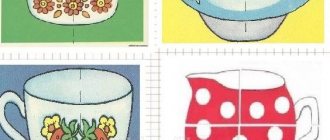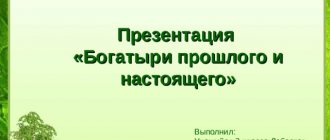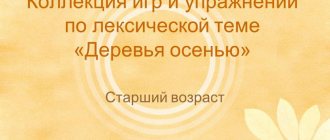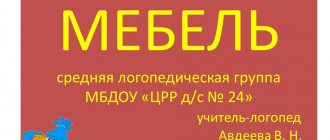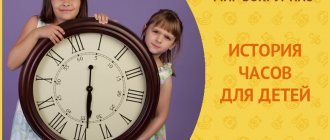Preview:
Presentation on the topic: “Cutlery”
Compiled by: Rakhmatova Anna Vladimirovna
The presentation is intended for children with disabilities (VIII type)
The presentation can be used in lessons on the development of speech and the surrounding world, as well as
The presentation consists of 20 slides.
The presentation is made in the form of a demonstration of pictures with captions for them.
- Photo of cutlery.
- Photo of a tablespoon.
- Photo of a dessert spoon.
- Photo of a teaspoon.
- Photo of the fork.
- Photo of the knife.
- Photo of how to hold a spoon correctly.
- Photo of how to use a knife and fork.
- Photo of how to use chopsticks.
- Photo of how to fold napkins.
- Photo of how to fold napkins.
- Photo of how to fold napkins.
- Photo of how to fold napkins.
- Photo of table setting for dinner.
- Photo table setting for the holiday.
- Photo of table setting scheme.
- Photo table setting.
- Resources used:
1.First, students are asked to name the subjects that they know. Transfer.
Source
Slide captions:
Introduction to the classification of tableware: Kitchen, dining, tea. performed by: Kholodova Tatyana Aleksandrovna
If there were no dishes, We would have had a very bad time. We would immediately turn from people into savages: We would take the meat with our hands, we would tear it with our teeth, we would drink water in the river, or in a dirty stream. Fortunately, various utensils help us everywhere: They put food on it, they eat and drink from it. They store food in it: Cheese and butter, bread and fruit... Hundreds of dishes are prepared in it - Boiled, fried and baked! What a helper she is!
And pancakes, and an omelet, and potatoes for lunch, and pancakes - wow! It fries everything. Who doesn’t have the answer - What should I cook my lunch in? There is a clean thing on the stove. Boil soup - you need...
It can be deep. It can be small. However, this is not a river. We need a set of dishes for lunch and dinner. Maybe it’s old, maybe it’s new, put the set on the table.
Everyone really likes her, a beauty on a silver platter, a cutie with one hand, little blue. Unapproachable in appearance, standing with her arms akimbo, But inside, look at the Treat inside! There is a button on the head, A sieve in the nose, One hand, And even that on the back.
I eat table soup for lunch, I try dessert with tea, Give me a little more, Where is my big one? On one wide leg it has 4 horns, but it is not a saw at all, for cutlets and meat. If sharpened well, it cuts everything very easily - Bread, potatoes, beets, meat, Fish, apples and butter.
Source
On the topic: methodological developments, presentations and notes
Presentation "TABLEWARE"
Development of coherent speech, enrichment of vocabulary and grammatical categories.
Presentation "Tableware"
Presentation on consolidating the names of dishes and cutlery (in riddles).
Presentation "Tableware"
Presentation for a conversation on cognition. Lexical topic “Dishes”. Puzzles.
Presentation “Dishes” (poem)
Presentation for a conversation on cognition. Lexical topic “Dishes”. Development of coherent speech, reading fiction, E. Nikolaeva’s poem “Dishes”.
Presentation "Tableware"
Educational presentation for middle school children on the topic “Utensils.” K. Chukovsky’s fairy tale “Fedorino’s grief” in an electronic version, as well as educational and gaming material on the topic “Cookware”.
Presentation “Clay dishes”
Abstract of direct educational activities on cognitive-speech and artistic-aesthetic development of children of senior preschool age.
Source
Presentation “The Tale of the Runaway Dishes”
- March 31, 2011
Competition “Presentation Master”
Game exercises to develop a sense of rhythm are not only educational in nature, but also have a certain therapeutic effect (they are aimed at relieving emotional stress and developing volitional efforts in a preschooler). What makes this form of work interesting not only for music directors, but also for other specialists working with preschool children: educators, additional education teachers, educational psychologists.
The presentation “The Tale of the Runaway Dishes” is intended for children of middle and senior preschool age.
Purpose of the presentation: developing a sense of rhythm.
The use of a fairy tale plot in a presentation contributes to the motivational inclusion of children in a gaming situation. For preschoolers, fairy tales are their “native language.” And the development of a sense of rhythm and free music playing (in those frames where the rhythm is not set) contribute to:
- Concentrating the child's attention on the piece being performed. Relieving emotional stress.
- Development of sensory-motor coordination.
- Development of visual and auditory attention, memory, observation.
- Learning ways to relieve tightness and stiffness, as well as coordinating your actions with other children.
- Learning to voluntarily respond to a musical signal.
- Developing the ability to convey the character and mood of music in free improvisations.
The presentation “The Tale of the Runaway Dishes” is the result of long-term work on developing a sense of rhythm.
Preparatory work:
- familiarization with the “big and small steps of music” (long and short sounds),
- playing with rhythmic syllables (ti is a short sound, ta is a long sound),
- working with rhythm cards (application),
- acquaintance with “non-traditional” instruments (mugs, graters, spoons, lids, glasses).
Working with a presentation:
- slides 2-5 – fairy tale.
- slides 6-10 – game with rhythm cards. The teacher pronounces the given rhythm, the children clap it and find the missing object. (Ta – big, ti – small).
- Slide 12 – rhythmic video game. The teacher draws the children’s attention to the fact that the instrument being played is the one indicated in the frame. Reproduction of a given rhythm is necessary when viewing frames with large and small objects. Where the rhythm is not indicated - free music playing.
- slide 14 – literature, authors.
Presentation “The Tale of the Runaway Dishes” (with sound)
Author: Authors: Dmitrieva Olga Valentinovna, additional education teacher of the 1st qualification category of the department of musical education of the Palace of Creativity of the city of Novorossiysk (19 years of experience in the specialty); Yulia Aleksandrovna Kurakina, educational psychologist at the Palace of Creativity in the city of Novorossiysk (8 years of experience in the specialty).
Slide captions:
Dishes Teacher Nikitina Olga Nikolaevna MBDOU Kindergarten No. 8 Kanash The presentation used: information and communication technologies, game technology.
Types of children's activities: gaming, communicative, cognitive and research. Objectives: Educational: To consolidate ideas about tableware, its diversity and purpose. Correctly name and distinguish dishes. Developmental: Expand vocabulary. Teach children how to form adjectives from nouns and give an idea of the materials from which utensils are made; Practice the formation and use of nouns with a diminutive suffix in speech; Develop attention, memory, logical thinking and coherent speech; Educational: To foster emotional responsiveness. Develop the ability to listen carefully to the short stories of your comrades on the topic.
Now I want to tell you riddles, and you think about what objects these riddles are about. In our kitchen We cook porridge in it, Potatoes, broths, Soups, pasta Saucepan In it I will fry a cutlet and potatoes without difficulty, I will bake pancakes for dinner, After all, it is a frying pan.
Has a trunk, not an elephant, He bows to the cups. I puff, puff, puff - I don’t want to get warm anymore. The lid rang loudly - Drink tea! — the water boiled. Kettle
It is necessary for us, After all, we eat food from it. Deep and shallow. Her name is.... With a plate we take it by the hand. We drink tea and coffee from it. Cup
They are all made of glass, intended for tea, juice, milk. Glasses
I don’t eat myself, but I feed people. Spoon I really like spare teeth - long, sharp, nimble when eating, do not bite or chew, only serve food. Fork.
On the topic: methodological developments, presentations and notes
Summary of an open lesson on table etiquette on the topic: “Introduction to the knife as a cutlery.” In the older group.
Summary of an open lesson on table etiquette on the topic: .
"Kingdom of Cutlery"
Scenario plan for direct educational activities Direction of activity: “Social and personal” Dominant educational area “Socialization”. Topic: “Co.
"Kingdom of Cutlery"
Expand knowledge about table setting and cutlery. To form an aesthetic attitude towards table setting, to practice the ability to decorate the table. Continue to strengthen the ability to maintain correctly.
Lesson on the topic: “Dinnerware, cutlery. Table etiquette"
Lesson on the topic: “Dinnerware, cutlery. Etiquette at the table” Teacher: Popova T.A.
"Dishes and cutlery"
How to practice with Cards"Dishes and cutlery"You can simply show the cards to a small child and name the objects depicted on them. After he remembers them, you can ask for them.
Lesson notes in prep.gr. “Dishes and cutlery. Rules of conduct at the table."
Summary of a conversation with children of senior preschool age on the topic: “Dishes and cutlery. Rules of conduct at the table."
Summary of educational activities in the middle group on the topic: “Dishes and cutlery.”
To develop knowledge about dishes and cutlery, to form in children an understanding of the need to use dishes for their intended purpose.
Source

